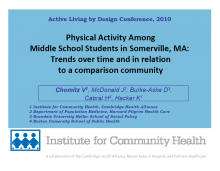We are pleased to announce an exciting new alliance between Active Living Research and GP RED to co-host and coordinate...
Physical Activity Among Middle School Students in Somerville, MA: Trends Over Time and In Relation to a Comparison Community

Presentation at the 2010 Active Living Research Annual Conference.
Visit the Active Living by Design Somerville project page.
Background:
Obesity continues to be a major public health problem in the United States. As of 2007, 28.8% of adolescents were either overweight or obese. The rise in obesity may, in part, be attributable to declines in physical activity (PA) levels. In 2007, only 34.7% of adolescents met the national PA guidelines. Since PA levels decrease between childhood and adolescence, the middle school transition is a particularly vulnerable period that warrants special attention.
In 2003, Somerville, Massachusetts organized an Active Living by Design (ALbD) partnership to promote community- wide active living through promotion activities (maps), policy changes, programs to engage immigrant communities, and physical changes to the environment (bike lines), and data gathering to evaluate these activities (student height, weight and fitness measurements). The partnership collaborated with other community initiatives to maximize the collective impact for health promotion.
Objectives:
This study evaluates PA among a diverse population of middle school students (6th-8th grades) in Somerville and a neighboring comparison community concurrent with Somerville’s ALbD promotion efforts. Specifically, we will 1) document Somerville PA trends over time; 2) examine between-city differences in meeting PA recommendations; 3) explore the relationship(s) of utilization of recreational space and social support on PA; and 4) discuss the policy implications of our findings.
Methods:
A retrospective observational study was conducted among 12 middle schools in Somerville and a socio-demographically comparison community in metro-Boston. The analytic approach was twofold. First, trend analysis assessed differences in PA levels within Somerville pre- (2003) and post- (2007) intervention. Second, between-city comparison analysis assessed differences in PA at post-intervention to explore the impact of city-specific utilization of recreational space and social support on PA levels.
Study data were from an anonymous, self-reported Youth Risk Behavior Survey from Somerville (2003, 2007) and the comparison city (2007 only). The survey included questions on demographics, television viewing, walking to school, and other health behaviors. In 2007, customized, supplemental questions regarding recreational space usage and social support for PA were added to the survey.
Somerville Trend Analysis, 2003-2007. Two outcome measures were used to assess meeting national PA recommendations: 1) moderate physical activity (MOD-PA), at least 30 minutes of physical activity 5 days per week and 2) vigorous physical activity (VIG-PA), at least 20 minutes of strenuous activity 3 days per week.
Between-City Comparison Analysis, 2007. Between-city comparison analysis added one outcome measure: 60 minutes of physical activity at least 5 days per week (60+PA), and included as covariates recreational space utilization and social support variables.
Statistical Analysis. Differences in outcome measures by demographic and health behaviors were assessed using chi-square analysis. Logistic regression modeling predicted the likelihood of meeting each outcome measure.
Results:
Approximately 1000 6th-8th grade students responded at each time point per city. Demographically, the communities were similar post-intervention, although significant changes in the racial/ethnic composition of Somerville students occurred 2003-2007; the percentage of Hispanic students increased (18.5% to 27.1%) and White students decreased (49.9% to 39.9%).
Somerville Trend Analysis, 2003-2007. Controlling for demographics, students were significantly more likely to meet MOD-PA (p<0.001) measure post-intervention (2007). Irrespective of year, significant predictors of meeting MOD-PA included being female (p<0.01), speaking English (p<0.01) and receiving fitness and nutrition instruction (p<0.05) at home.
Between-City Analysis, 2007. Controlling for demographics, Somerville students were significantly more likely to meet the 60+PA recommendation (p<0.01) than their comparison-community counterparts. Irrespective of city, significant predictors of meeting 60+PA included using public spaces for recreation (p<0.001), being male (p<0.001), receiving PA encouragement (p<0.10) and speaking English (p<0.001) at home.
Recreational Space and Social Support. Overall, Somerville students were more likely to access public recreational spaces for PA: school playground (p<0.001), neighborhood parks (p<0.001) and community walk/bike paths (p<0.05). No significant differences in social support were observed between the two cities.
Conclusions:
A significantly greater proportion of Somerville middle school students met MOD-PA recommendations in 2007 versus 2003, suggesting that despite demographic changes in the population, community efforts may have enhanced student’s ability to be moderately physically active. Between-city comparisons demonstrated higher 60+PA recommendation compliance in Somerville. Further research is needed to understand why student’s who utilized public recreational spaces at higher rates were more likely to meet the 60+PA recommendation. Were utilization rates higher because Somerville students’ had greater access to recreational spaces or because the spaces and/or PA were more heavily promoted? Moreover, students in either city were more likely to meet MOD-PA or 60+PA recommendations if they were White, English-speaking and received support for PA at home. Females were more likely to meet the MOD-PA recommendation in the trend analysis, whereas males were more likely to meet the 60+PA recommendation in the between-city comparison, suggesting the relationship of gender to PA behaviors is complex. These results highlight ongoing racial/ethnic and gender disparities in PA and underscore the importance of community-specific participatory research to enhance PA for specific populations.
Support:
This research was funded by a grant from the Robert Wood Johnson Foundation’s Active Living Research Program.
Related Tools & Resources
STAY UP TO DATE
RECENTLY ADDED TOOLS & RESOURCES
MOVE! A BLOG ABOUT ACTIVE LIVING
The "Active Living Conference" aims to break down research and practice silos and...







